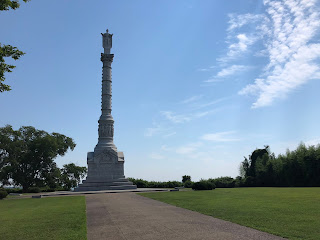Years ago, we visited Yorktown, but never visited the Colonial National Historical Park. We picked a beautiful day and arrived about 30 minutes after it opened.
While we waited for the start of the 16-minute overview film of the Yorktown Historical site "The Siege at Yorktown".
Yorktown was established as a 50 acre plot of land designated in 1691 by an Act for Ports passed by the Virginia House of Burgess. It had a customs house for the purposes of collecting taxes on shipments along the York River.
It had a population of about 1800 people by the early 1700's and with the primary cash crop of tobacco being grown and shipped out of the region.
Even before the colonial declaration of Independence in 1776, relations with Britain were locked in skirmishes of the Revolutionary War. In 1780, French forces landed near Rhode Island to aid their American friends. At sea, the French fleet blockaded the Chesapeake, depriving British forces an avenue of escape.
British General Cornwallis moved his army toward Yorktown to establish a naval base there. With a force of 8,300 men, he fortified the town and prepared for battle against the larger French and colonial forces near Williamsburg that was close to 17,000.
The allied forces began a nine-day round-the-clock bombardment of Yorktown pinning Corwallis and his army down with no escape. Cornwallis requested a cease-fire to discuss surrender terms and on October 19, 1781 he formally surrendered his army
We walked through the museum and then down to path to the area of old Yorktown.
The pathway made for an easy walk. I like the detailed maps along the way.
About 500 yards down the path toward town, the Victory Monument. With the defeat of Cornwallis, citizens immediately knew the significance of the event. News reached the Continental Congress a few days later and on October 29, 1781 directed that a monument be erected.
In what may be the slowest construction plan in history, the cornerstone was not laid until October 1881.
As we continued on the walking tour, we passed the Nelson House. Thomas Nelson Jr. was one of Yorktown's influential citizens. He was a signer of the Declaration of Independence and owned this home that was built by his grandfather in about 1730.
We walked up the steps and onto the property and found a few shaded benches in the back of the house overlooking an active garden that was being tended by a volunteer.
It was time for lunch and had a picnic. It's been fun to remember all the places we've packed a lunch and enjoyed the surroundings all over the country. This simple pleasure has brought us great joy as we've been to different places and soaked in the history and surroundings.
This home was built in the Georgian architecture style, named after the British kings by that name.We wandered down the lane of old homes and taverns and walked over to the Yorktown Beach. This was a surprise.
The Riverwalk Landing is nice little city park with public facilities and a shaded tree line with park benches. It overlooks the wharf and the York River.
After some time at the Riverwalk Landing, we looked at the city map and found the nearest trolley stop to get back to the Visitor Center. It was heating up and getting a little humid, but it was a great day in Yorktown.
We felt like we added a little more understanding of the early days in our country.
Thanks for joining us on the Roadrunner Chronicles!

















That area is on our see soon list.
ReplyDeleteWe love the history in that part of Virginia. The big trifecta.
ReplyDeleteYes, there is so much to see. The history lesson never ends!
DeleteGreat post, we have been there many times and I hope we will return again:)
ReplyDelete